Butterflies and Moths
Media
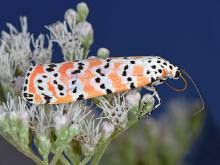
Species Types
Scientific Name
Utetheisa ornatrix
Description
The ornate bella moth, also called the calico moth and rattlebox moth, is one of Missouri’s most attractive moths. The colors, however, are a warning to predators that this moth is toxic if eaten. Even spiders reject them.
Media
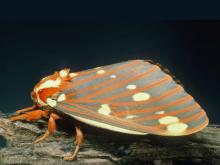
Species Types
Scientific Name
Citheronia regalis
Description
The enormous, horned caterpillars of regal moths are more famous than the winged adults. This splendid moth is well established in the Ozarks and eastern Missouri.
Media

Species Types
Scientific Name
Eacles imperialis
Description
The beautiful imperial moth is impossible to confuse with any other species in Missouri: the wings are yellow with spots and speckles of pink, orange, or rusty pale purple. Wingspan can be 5½ inches.
Media

Species Types
Scientific Name
More than 12,000 species in North America north of Mexico
Description
Learn about moths as a group. What makes a moth a moth? How are moths different from butterflies? What are the major groups of moths?
Media
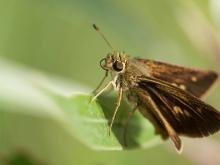
Species Types
Scientific Name
About 275 species in North America north of Mexico
Description
At first glance, skippers look halfway between butterflies and moths. They are commonly seen darting among the flowers they visit on hot summer days.
Media

Species Types
Scientific Name
More than 700 species in North America north of Mexico
Description
Learn about butterflies and skippers as a group. What makes a butterfly a butterfly? How are they different from moths? What are the major groups of butterflies?
Media

Species Types
Scientific Name
Polygonia progne
Description
The gray comma is easy to ID if you can see the underside: it is charcoal gray with many fine dark streaks, and its comma marking is L-shaped and narrows to a fine point at each end.
Media
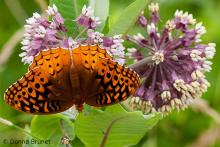
Species Types
Scientific Name
Speyeria cybele
Description
The great spangled fritillary is common and easily recognized. This glorious butterfly is often seen in city yards and gardens as it seeks flowers.
Media
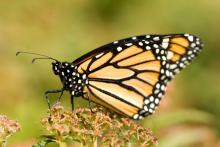
Species Types
Scientific Name
Danaus plexippus
Description
Monarchs are well-known butterflies distinguished by their relatively large size, rusty or orange wings with black veins, and black bodies. The larvae usually are found on milkweeds.
Media
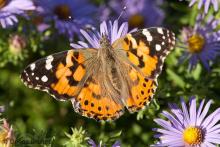
Species Types
Scientific Name
Vanessa cardui
Description
The painted lady is a delicately patterned butterfly found nearly worldwide. It migrates to Missouri in spring. There are several broods.
See Also


Media

Species Types
Scientific Name
About 1,500 species in North America north of Mexico
Description
Adult caddisflies are mothlike. Their larvae are aquatic and build portable, protective cases out of local materials, including grains of sand, bits of leaves and twigs, and other debris.
Media

Species Types
Scientific Name
Corydalus cornutus
Description
Adult eastern dobsonflies are huge and mothlike, with large wings and a weak, fluttery flight. The fiercely predaceous aquatic larvae, called hellgrammites, are well-known to anglers, who often use them as bait.
About Butterflies and Moths in Missouri
Butterflies, skippers, and moths belong to an insect order called the Lepidoptera — the "scale-winged" insects. These living jewels have tiny, overlapping scales that cover their wings like shingles. The scales, whether muted or colorful, seem dusty if they rub off on your fingers. Many butterflies and moths are associated with particular types of food plants, which their caterpillars must eat in order to survive.





















